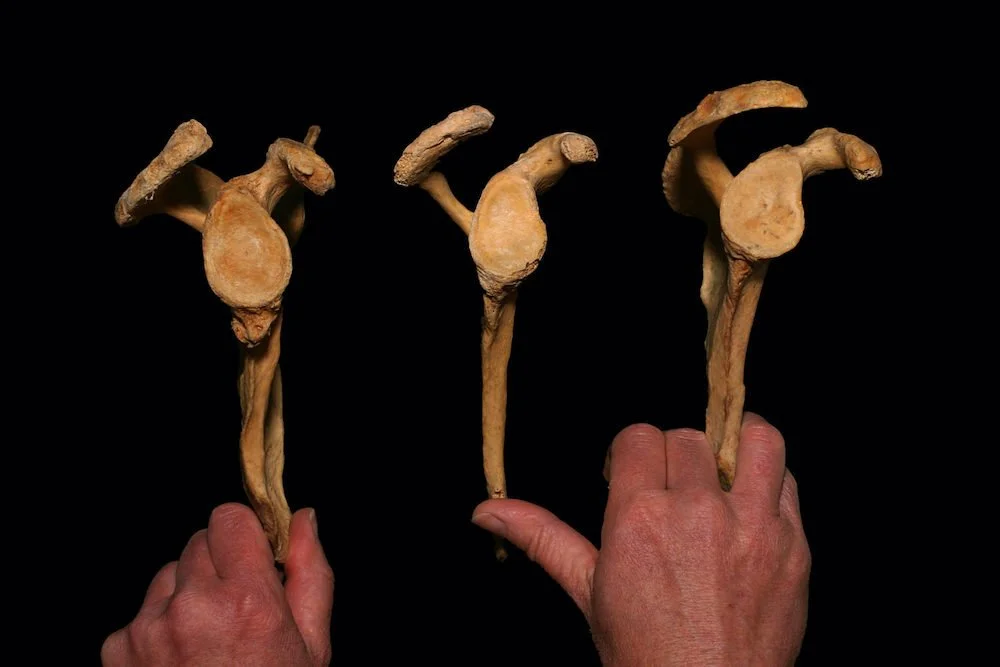It’s very common for yoga teachers to cue external rotation of the shoulder joint in Downward Facing Dog. There is a widespread belief that externally rotating the shoulder joint when weight-bearing is the correct choice while internal rotation here is bad and potentially injurious. Read on to find out more!
Also known as the glenohumeral joint, the shoulder joint is a ball-and-socket joint that involves the articulation between the head of the humerus and the shallow glenoid fossa on the lateral surface of the scapula.
We each have entirely unique shoulder joints. The image below, courtesy of Paul Grilley, showing the lateral view of three different scapulae demonstrate this perfectly. Any precise, dogmatic cue will never work for everyone in a group setting.
There is a widespread misconception that external rotation of the shoulder joint is more “spacious” for the joint than internal rotation. I believe that this stems from the idea of subacromial/shoulder impingement, a diagnosis given to people who have antero-lateral shoulder pain often experienced when the arm is elevated.
This is based on a *hypothesis* that the acromion of the scapula pinches on the bursa and rotator cuff muscles (shown below) causing irritation and abrasion. Neer (1972) argued that this occurs principally in flexion of the shoulder joint and described a clinical test, the ‘(Neer) impingement sign’ to reproduce the associated symptoms. The test involves restricting scapular movement and forcing the arm into flexion while the shoulder joint remains internally rotated (Neer 1983). According to Neer, this maneuver causes the greater tuberosity of the humerus to impinge against the acromion. He argued that 95% of rotator cuff tears are initiated by impingement and that trauma may enlarge a tear but is rarely the principal factor. Neer also stated that the reason rotator cuff tears develop in some people and not others is principally due to the shape of the acromion.
However, surgery aiming to remove the cause of the impingement irritation (i.e. the acromion) is no more clinically effective than a structured rehabilitation programme (Ketola et al 2017). There is little evidence for an acromial impingement model, and it has been suggested that a more appropriate name for this condition is subacromial pain syndrome or SAPS (Lewis 2011). A syndrome is a recognizable complex of symptoms and physical findings which indicate a specific condition for which a direct cause is not necessarily understood!
There tend to be few opportunities to actively internally rotate the shoulder joints in a traditional yoga practice. We mainly use internal rotation to help us to bind and then focus on external rotation. My suggestion is that we explore active external rotation AND internal rotation in our practice and then in asanas such as Downward Facing Dog we can explore this full range and find our own sweet spot in that moment.
References:
Ketola, S., Lehtinen, J. and Arnala, I. (2017) ‘Arthroscopic decompression not recommended in the treatment of rotator cuff tendinopathy: a final review of a randomised controlled trial at a minimum follow-up of ten years.’ Bone Joint J 99, 6, 799–805.
Lewis J. (2011) ‘Subacromial impingement syndrome: a musculoskeletal condition or a clinical illusion?’ Physical Therapy Reviews 16, 5, 388-398.
Neer, C. (1972) ‘Anterior acromioplasty for the chronic impingement syndrome in the shoulder: a preliminary report.’ J Bone Joint Surg Am 54, 41–50.
Neer, C. (1983) ‘Impingement lesions.’ Clin Orthop Relat Res 173, 70–7.


